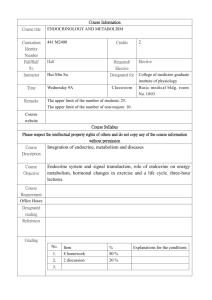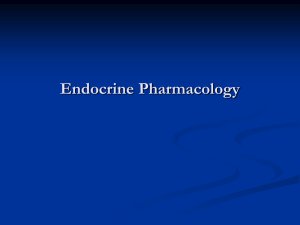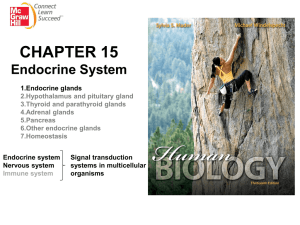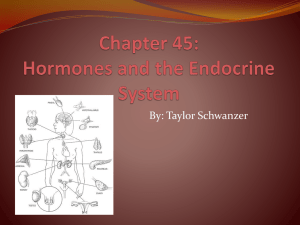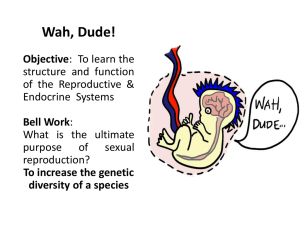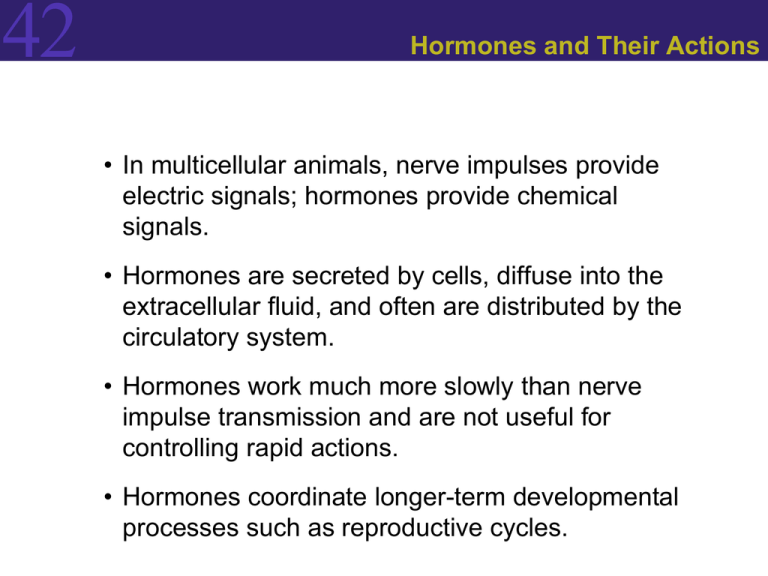
42
Hormones and Their Actions
• In multicellular animals, nerve impulses provide
electric signals; hormones provide chemical
signals.
• Hormones are secreted by cells, diffuse into the
extracellular fluid, and often are distributed by the
circulatory system.
• Hormones work much more slowly than nerve
impulse transmission and are not useful for
controlling rapid actions.
• Hormones coordinate longer-term developmental
processes such as reproductive cycles.
42
Hormones and Their Actions
• Hormone-secreting cells are called endocrine
cells.
• Cells receiving the hormonal message are called
target cells and must have appropriate receptors.
42
Hormones and Their Actions
• Hormones can be classified into three main groups:
Peptides or proteins. They are water soluble and
transported by vesicles out of the cell that made
them.
Steroid hormones are lipid-soluble and can
diffuse out of the cell that made them but in the
blood they must be bound to carrier proteins.
Amine hormones are derivatives of the amino
acid tyrosine. Some are water-soluble and some
are lipid-soluble.
42
Hormones and Their Actions
• Some hormones act locally.
• Autocrine hormones act on the secreting cell
itself.
• Paracrine hormones act on cells near the site of
release.
• Most hormones travel in blood to different tissues
and cells.
42
Hormones and Their Actions
• Endocrine refers to cells or glands that do not
have ducts leading to the outside of the body;
they secrete their products directly into the
extracellular fluid.
• In vertebrates, nine major endocrine glands make
up the endocrine system.
Figure 42.2 The Endocrine System of Humans
42
Vertebrate Endocrine Systems
• The pituitary gland of mammals is a link
between the nervous system and many endocrine
glands and plays a crucial role in the endocrine
system.
• The pituitary gland sits in a depression at the
bottom of the skull and is attached to the
hypothalamus.
• The pituitary is made of two parts: anterior and
posterior.
42
• Add anatomy slides in here
• Make a handout of the major hormones and
actions.
Figure 42.8 Multiple Feedback Loops Control Hormone Secretion
Figure 42.10 The Adrenal Gland Has an Outer and an Inner Portion
42
Vertebrate Endocrine Systems
• Until the seventh week of an embryo’s
development, either sex may develop.
• In mammals, the Y chromosome causes the
gonads to start producing androgens in the
seven-week-old embryo, and the male
reproductive system develops.
• If androgens are not released, the female
reproductive system develops.
• In birds, the opposite rules apply: male features
are produced unless estrogens are present to
trigger female development.
Figure 42.12 The Development of Human Sex Organs
42
Vertebrate Endocrine Systems
• Sex steroid production increases rapidly at
puberty, or sexual maturation, in humans.
• Control of sex steroids (both male and female) is
under the anterior pituitary tropic hormones called
luteinizing hormone (LH) and follicle-stimulating
hormone (FSH).
• These gonadotropins are controlled by the
hypothalamic gonadotropin-releasing hormone
(GnRH).
• Before puberty, the hypothalamus produces low
levels of GnRH.
42
Vertebrate Endocrine Systems
• Puberty starts when the hypothalamus becomes
less sensitive to negative feedback by the sex
steroids.
• GnRH release increases, stimulating
gonadotropin production and, hence, sex steroid
production.
• In females, increased LH and FSH at puberty
induce the ovaries to begin female sex hormone
production to initiate sexually mature body traits.
• In males, increased LH stimulates cells in the
testes to make androgens which induce changes
associated with adolescence.
42
Vertebrate Endocrine Systems
• Melatonin hormone is produced by the pineal
gland, located between the cerebral hemispheres
of the brain.
• Melatonin release occurs in the dark, marking the
length of night. Exposure to light inhibits
melatonin release.
• Melatonin is involved in biological rhythms,
including photoperiodicity.
• In many animals, increasing day length signals
the onset of reproductive behavior.
• Humans are not photoperiodic, but melatonin may
be involved in daily rhythms of the body (light/dark
cycles).
42
Hormone Actions:
The Role of Signal Transduction Pathways
• Hormones are released in very small amounts,
yet they cause large and very specific responses
in target organs and tissues.
• Strength of hormone action results from signal
transduction cascades that amplify the original
signal.
• Selective action is keyed to appropriate receptors
of cells responding to hormones.
• Specific receptors can also be linked to different
response mechanisms, as is the case with
receptors for epinephrine and norepinephrine.
42
Hormone Actions:
The Role of Signal Transduction Pathways
• The abundance of hormone receptors can be
under feedback control.
• Continuous high levels of a hormone can
decrease the number of its receptors, a process
called downregulation.
• High levels of insulin in type II diabetes mellitus
result in a loss of insulin receptors.
• Upregulation of receptors is a positive feedback
mechanism and is less common than
downregulation.
42
Hormone Actions:
The Role of Signal Transduction Pathways
• The concentration of hormones and receptors can
be determined by a technique called
immunoassay.
• A saturating concentration of a labeled hormone
is mixed with an antibody until all the binding sites
of the antibody are used.
• A sample of unlabeled hormone is then added to
the mixture.
• The unlabeled hormone displaces some of the
labeled hormone from the antibody.
• The ratio of labeled to unlabeled antibody is a
measure of the amount of unlabeled hormone.


